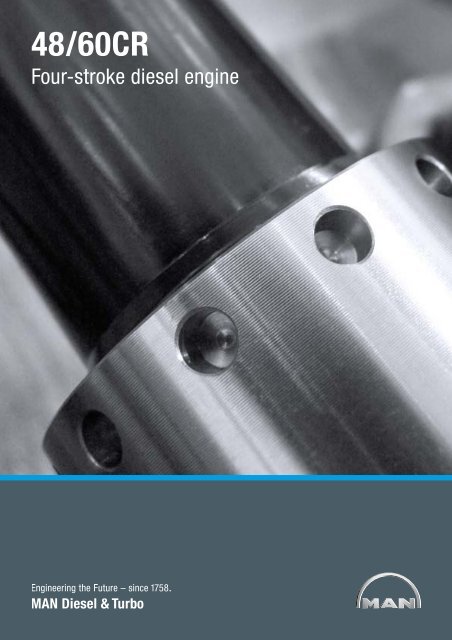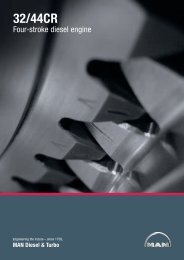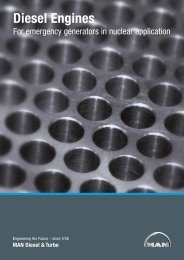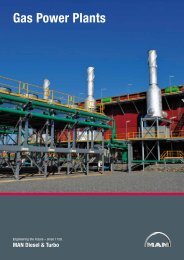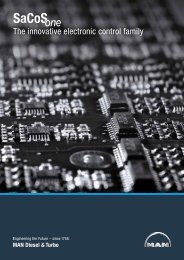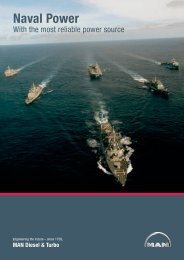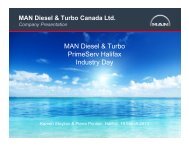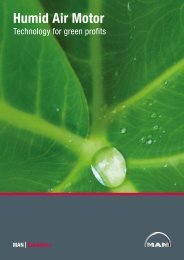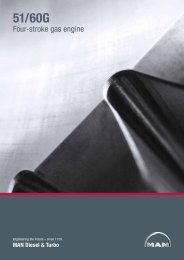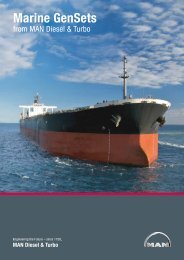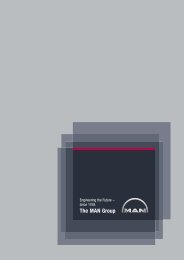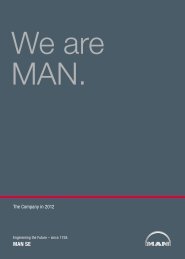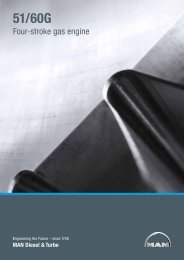48/60CR - MAN Diesel & Turbo Canada
48/60CR - MAN Diesel & Turbo Canada
48/60CR - MAN Diesel & Turbo Canada
Create successful ePaper yourself
Turn your PDF publications into a flip-book with our unique Google optimized e-Paper software.
<strong>48</strong>/<strong>60CR</strong><br />
Four-stroke diesel engine
<strong>MAN</strong> <strong>Diesel</strong> & <strong>Turbo</strong><br />
The responsible way in leading technology<br />
<strong>MAN</strong> <strong>Diesel</strong> & <strong>Turbo</strong> is the world’s leading designer and manufacturer of low and<br />
medium speed engines – engines from <strong>MAN</strong> <strong>Diesel</strong> & <strong>Turbo</strong> cover an estimated<br />
50% of the power needed for all world trade. We develop two-stroke and fourstroke<br />
engines, auxiliary engines, turbochargers and propulsion packages that are<br />
manufactured both within the <strong>MAN</strong> <strong>Diesel</strong> & <strong>Turbo</strong> Group and at our licensees.<br />
More than ever before, <strong>MAN</strong> <strong>Diesel</strong> & <strong>Turbo</strong>’s development focus is the environmental<br />
performance of our engines.<br />
Using our unrivalled grasp of large engine technology, we aim to make our engines<br />
progressively cleaner, more powerful and more efficient.<br />
Our absolute commitment to reducing emissions while increasing fuel efficiency<br />
and power density starts with our active partnership in the emissions law making<br />
process and ends with the delivery of engines that achieve an ideal synthesis of<br />
prime mover characteristics.<br />
<strong>48</strong>/<strong>60CR</strong> – Four-stroke diesel engine<br />
3
Efficient, Clean and Compact<br />
<strong>48</strong>/<strong>60CR</strong> sets new standards in engine class<br />
By the use of electronic injection, variable valve timing, improved turbocharger<br />
and by improved combustion, increasingly stringent emission standards can be<br />
fulfilled and improved part load performance (smoke, SFOC) can be obtained<br />
without compromising on the engines high availability and specific power output.<br />
Core technologies in-house<br />
Miller valve timing<br />
As well as its expertise in engine design, development<br />
and manufacture <strong>MAN</strong> <strong>Diesel</strong> & <strong>Turbo</strong> is also a leading<br />
manufacturer of the key technologies which determine<br />
the economic and ecological performance of a diesel<br />
engine:<br />
• High-efficiency exhaust gas turbochargers<br />
• Advanced electronic fuel injection equipment<br />
To reduce the temperature peaks which promote the<br />
formation of NO x , early closure of the inlet valve causes<br />
the charge air to expand and cool before start of compression.<br />
The resulting reduction in combustion temperature<br />
reduces NO x emissions.<br />
New piston for increased compression ratio<br />
Flexible common rail injection<br />
Committed to the future<br />
• Electronic hardware and software for engine control,<br />
monitoring and diagnosis<br />
Our impressive array of computer-aided design tools<br />
and one of the engine industry’s largest, best-equipped<br />
foundries allow us decisively to shorten product development,<br />
and application engineering processes.<br />
Our grap on these engine technologies are the firm<br />
foundation for<br />
• Low emissions<br />
• Low operating costs<br />
• Low life cycle costs<br />
• Long service life<br />
The range of technical measures employed comprises:<br />
• Improved charge air cooling<br />
• Enhanced turbocharging<br />
• Miller valve timing<br />
The use of a new piston provides a higher compression<br />
ratio and gives a faster reduction in temperature after<br />
the ignition of the fuel, thus reducing NO x formation.<br />
VVT variable valve timing<br />
Variable valve timing enables variations in the opening<br />
and closing of the inlet valves. It can be used to<br />
compensate the increase in SFOC associated with<br />
lower NO x emissions. VVT is an enabling technology<br />
of variable Miller valve timing. A strong Miller effect<br />
under high load operation results in an improvement in<br />
the NO x -SFOC trade-off. At low load the Miller valve<br />
timings are reduced to attain higher combustion temperatures<br />
and thus lower soot emissions.<br />
The <strong>48</strong>/60 CR injection system uses the latest<br />
<strong>MAN</strong> <strong>Diesel</strong> & <strong>Turbo</strong> common rail technology which<br />
allows flexible setting of injection timing, duration and<br />
pressure for each cylinder. This flexibility allows the<br />
fuel consumption and emissions of the <strong>48</strong>/<strong>60CR</strong> to<br />
be optimised at any point on its operating profile.<br />
Safety concept<br />
The common rail system comprises an intelligent designed<br />
safety concept:<br />
• All high pressure pipes are screened or have a double<br />
wall design.<br />
• Flow limiting valves at each cylinder prevent uncontrolled<br />
injection.<br />
• Redundant high pressure pumps guarantee further<br />
operation of the engine even in the event of high<br />
pressure pump malfunction.<br />
• Redundant twin type pressure sensors and speed<br />
Technologies which promise compliance with the IMO<br />
Tier III round of emissions limits due in 2016 combined<br />
with further optimised fuel consumption and<br />
new levels of power and flexibility are already under<br />
development at <strong>MAN</strong> <strong>Diesel</strong> & <strong>Turbo</strong>. With this level of<br />
commitment <strong>MAN</strong> <strong>Diesel</strong> & <strong>Turbo</strong> customers can plan<br />
with confidence.<br />
High performance turbocharger<br />
The use of <strong>MAN</strong> <strong>Diesel</strong> & <strong>Turbo</strong> turbochargers equipped<br />
with the latest high efficiency compressor wheels can<br />
alleviate the NO x -SFOC trade off. This also benefits the<br />
achievment of higher charge air pressures with the given<br />
energy input and thus compensates the increase in<br />
SFOC normally associated with lower NO x emissions.<br />
Further benefit: Increased Miller valve timing due to<br />
available higher charge air pressure.<br />
• Flexible injection timing<br />
• Higher compression ratios<br />
• Low swirl inlet ports<br />
• Variable valve timing (VVT)<br />
sensors assure that the engine stays operational<br />
even in the event of failure of one of these elements.<br />
In case of single engine plants the ECUs (Electronic<br />
Control Units) are in double type as well.<br />
4 <strong>48</strong>/<strong>60CR</strong> – Four-stroke diesel engine<br />
<strong>48</strong>/<strong>60CR</strong> – Four-stroke diesel engine 5
Modern and Innovative Technology<br />
<strong>48</strong>/<strong>60CR</strong> – “The modern powerhouse”<br />
Synonymous with top performance and excellent flexi bility. With the <strong>48</strong>/<strong>60CR</strong>,<br />
<strong>MAN</strong> <strong>Diesel</strong> & <strong>Turbo</strong> is embarking on a new era in modern diesel engine design. Based<br />
on the more than 600-fold well proven <strong>48</strong>/60 engine, the <strong>48</strong>/<strong>60CR</strong> was developed<br />
for use as a propulsion engine in cruise liners, tankers or container ships.<br />
Features and advantages<br />
Fuels<br />
As a matter of principle, <strong>MAN</strong> <strong>Diesel</strong> & <strong>Turbo</strong> has kept<br />
the basic concept of its Common Rail Technology<br />
as simple as possible and has integrated technically<br />
proven components into the design. For example, in<br />
keeping with this philosophy, the design does not use<br />
a separate servo circuit for activating the injection valve.<br />
Less maintenance is one of the benefits as well as<br />
extremely quick and accurate reaction times of the<br />
injection system. The electronically controlled injection<br />
valves are on the rail outside the cylinder head, resulting<br />
in greater system reliability and easy maintainability.<br />
Also, integrated into the CR techno logy are well-proven<br />
components with long service experience, such as<br />
conventional injection nozzles. With the <strong>48</strong>/<strong>60CR</strong> it<br />
has been possible to combine conflicting development<br />
specifications like “high power density” and “low<br />
emissions” with “low wear” in a revolutionary way.<br />
Injection<br />
The patented injection system from <strong>MAN</strong> <strong>Diesel</strong> & <strong>Turbo</strong><br />
is based on the following principle: High pressure<br />
pumps compress the fuel to the required pressure<br />
and deliver it to the inline accumulator units (common<br />
rail). The common rail system achieves its high level of<br />
flexibility by consistent separation of pressure generation<br />
and injection control.<br />
The common rail injection system of the <strong>48</strong>/<strong>60CR</strong> was<br />
designed for operation with heavy fuel oil (HFO) in<br />
accordance with specification DIN ISO 8217 (viscosities<br />
up to 700 cSt at 50 °C) and fuel temperatures<br />
up to 150 °C. The fuel oil system is designed to allow<br />
the engine to be started and stopped with HFO.<br />
Electronics<br />
The <strong>48</strong>/<strong>60CR</strong> is equipped with the well proven Safety<br />
and Control System SaCoS one . As an in-house development<br />
it is best adapted to <strong>MAN</strong> <strong>Diesel</strong> & <strong>Turbo</strong><br />
engines. SaCoS one combines all functions of a modern<br />
engine management system within one complete system.<br />
SaCoS one offers:<br />
• Integrated self-diagnosis functions<br />
• Maximum reliability and availability<br />
• Simple use and diagnosis<br />
• Quick exchange of modules (plug in)<br />
• Trouble-free and time-saving commissioning<br />
General definition of diesel engine ratings<br />
according to ISO 3046-1:2002<br />
ISO reference conditions<br />
Air temperature: 298 K (25°C)<br />
Air pressure: 1 bar<br />
Fresh water temperature upstream of charge-air<br />
cooler: 298 K (25 °C)<br />
Relative humidity: 30%<br />
No power reduction required up to below<br />
Air temperature: 318 K (45 °C)<br />
Air pressure: 1 bar<br />
Fresh water temperature upstream of<br />
charge-air cooler: 311 K (38 °C)<br />
IMO requirements<br />
The engine detailed herein will comply with the<br />
emission limits referred to as IMO Tier II.<br />
MCR = maximum continuous rating<br />
Engine data for <strong>48</strong>/<strong>60CR</strong><br />
General<br />
Engine cycle: four-stroke<br />
<strong>Turbo</strong>charging system: constant-pressure<br />
Number of cylinders, in-line engine: 6, 7, 8, 9<br />
Number of cylinders, V-engine: 12, 14, 16, 18<br />
Bore: <strong>48</strong>0 mm<br />
Stroke: 600 mm<br />
Swept volume per cyl: 108.6 dm 3<br />
Power-to-weight ratio (MCR)<br />
In-line engine: 13.7 – 14.7 kW/kg<br />
V-engine: 12.3 – 13.1 kW/kg<br />
Cylinder output (MCR)<br />
at 514 / 500 rpm: 1,200 kW<br />
Cooling<br />
Cylinder cooling: fresh water<br />
Charge-air cooler (two-stage): fresh water<br />
Fuel injector cooling: fresh water<br />
Starting method: compressed air<br />
6 <strong>48</strong>/<strong>60CR</strong> – Four-stroke diesel engine<br />
L+V<strong>48</strong>/<strong>60CR</strong> – Four-stroke diesel engine 7
Technical Data<br />
<strong>48</strong>/<strong>60CR</strong><br />
Dimensions and Weights<br />
All cylinder numbers<br />
Specific Fuel Oil Consumption (SFOC) to ISO conditions<br />
L<strong>48</strong>/<strong>60CR</strong><br />
V<strong>48</strong>/<strong>60CR</strong><br />
100% load 85% load<br />
L<strong>48</strong>/<strong>60CR</strong> 183 g/kWh 175 g/kWh<br />
V<strong>48</strong>/<strong>60CR</strong> 181 g/kWh 173 g/kWh<br />
The fuel consumption rates are based on a lower calorific value (LHV) of the fuel of 42,700 kJ/kg without engine driven pumps. Tolerance +5%.<br />
Engine type specific reference charge air temperature before cylinder 34 °C.<br />
Specific lubricating oil consumption<br />
L+V<strong>48</strong>/<strong>60CR</strong><br />
0.6 g/kWh<br />
The lube oil consumption is given with a tolerance of +20%<br />
Power unit output (maximum continuous rating)<br />
In-line engine L<strong>48</strong>/<strong>60CR</strong><br />
Engine speed 514 rpm 500 rpm<br />
Mean piston speed 10.3 m/s 10.0 m/s<br />
Mean effective pressure 25.8 bar 26.5 bar<br />
kW<br />
kW<br />
6L<strong>48</strong>/<strong>60CR</strong> 6 cyl. 7,200 7,200<br />
7L<strong>48</strong>/<strong>60CR</strong> 7 cyl. 8,400 8,400<br />
8L<strong>48</strong>/<strong>60CR</strong> 8 cyl. 9,600 9,600<br />
9L<strong>48</strong>/<strong>60CR</strong> 9 cyl. 10,800 10,800<br />
12V<strong>48</strong>/<strong>60CR</strong> 12 cyl. 14,400 14,400<br />
14V<strong>48</strong>/<strong>60CR</strong> 14 cyl. 16,800 16,800<br />
16V<strong>48</strong>/<strong>60CR</strong> 16 cyl. 19,200 19,200<br />
18V<strong>48</strong>/<strong>60CR</strong> 18 cyl. 21,600 21,600<br />
Engine type No. of cyl. L L1 W H Wt.<br />
mm mm mm mm t<br />
6L<strong>48</strong>/<strong>60CR</strong> 6 8,615 7,455 3,195 5,360 106<br />
7L<strong>48</strong>/<strong>60CR</strong> 7 9,435 8,275 3,195 5,360 119<br />
8L<strong>48</strong>/<strong>60CR</strong> 8 10,460 9,095 3,325 5,360 135<br />
9L<strong>48</strong>/<strong>60CR</strong> 9 11,425 9,915 3,325 5,360 1<strong>48</strong><br />
Minimum centreline distance for twin engine installation: 3,200 mm.<br />
V-engine V<strong>48</strong>/<strong>60CR</strong><br />
Engine type No. of cyl. L L1 W H Wt.<br />
mm mm mm mm t<br />
12V<strong>48</strong>/<strong>60CR</strong> 12 10,760 9,088 4,700 5,355 189<br />
14V<strong>48</strong>/<strong>60CR</strong> 14 11,760 10,088 4,700 5,355 213<br />
16V<strong>48</strong>/<strong>60CR</strong> 16 13,100 11,088 4,700 5,355 240<br />
18V<strong>48</strong>/<strong>60CR</strong> 18 14,100 12,088 4,700 5,355 265<br />
Minimum centreline distance for twin engine installation: 4,800 mm.<br />
8 <strong>48</strong>/<strong>60CR</strong> – Four-stroke diesel engine<br />
<strong>48</strong>/<strong>60CR</strong> – Four-stroke diesel engine 9
World Class Service<br />
Marine propulsion and GenSets<br />
Service Facitities<br />
(Service Centres,<br />
Authorized Repair Shops,<br />
Spare Parts Stocks)<br />
Agencies<br />
PrimeServ – peace of mind for life<br />
With more than 150 PrimeServ service stations and<br />
service partners worldwide, plus our growing network<br />
of PrimeServ Academies, the <strong>MAN</strong> <strong>Diesel</strong> & <strong>Turbo</strong> aftersales<br />
organisation is committed to maintaining the most<br />
efficient and accessible after-sales organisation in the<br />
business.<br />
PrimeServ’s aim is to provide:<br />
• Prompt delivery of high demand OEM spare parts<br />
within 24 hours.<br />
• Fast, reliable and competent customer support.<br />
• Individually tailored O&M contracts.<br />
• Ongoing training and qualification of service personnel.<br />
• Global service, open 24 hours-a-day, 365 days-a-year.<br />
• Diagnosis and troubleshooting with our high performance<br />
Online Service.<br />
The PrimeServ offering<br />
Based on almost 110 years of service experience with<br />
marine diesel engines, our sophisticated logistics system<br />
ensures that all frequently requested spare parts are<br />
available worldwide within 24 hours. In addition, <strong>MAN</strong><br />
<strong>Diesel</strong> & <strong>Turbo</strong> Online Service helps to optimise maintenance<br />
cycles by the use of remote engine monitoring,<br />
diagnostics and calibration. The resulting conditionbased<br />
maintenance (CBM) promotes high availability,<br />
increases operational safety, shortens downtimes and<br />
enhances the performance of <strong>MAN</strong> <strong>Diesel</strong> & <strong>Turbo</strong> marine<br />
engines.<br />
The bottom line: leaner operating costs and better<br />
planning for you.<br />
When service is required, the <strong>MAN</strong> PrimeServ network<br />
responds to organise assistance as fast as possible.<br />
This guarantees rapid completion of maintenance work<br />
and high availability of <strong>MAN</strong> <strong>Diesel</strong> & <strong>Turbo</strong> engines,<br />
GenSets, turbochargers, gears, propellers and marine<br />
propulsion packages.<br />
In short: <strong>MAN</strong> PrimeServ gives you the benefit of our<br />
specialist expertise in marine power so that you can<br />
10 <strong>48</strong>/<strong>60CR</strong> – Four-stroke diesel engine<br />
concentrate on your own core business.<br />
L+V<strong>48</strong>/<strong>60CR</strong> – Four-stroke diesel engine 11
All data provided in this document is non-binding. This data serves informational purposes only and is especially not guaranteed in any way. Depending on the subsequent specific<br />
individual projects, the relevant data may be subject to changes and will be assessed and determined individually for each project. This will depend on the particular characteristics of<br />
each individual project, especially specific site and operational conditions · Copyright © <strong>MAN</strong> <strong>Diesel</strong> & <strong>Turbo</strong> · D2366372EN-N6 Printed in Germany GMC-AUG-05122<br />
<strong>MAN</strong> <strong>Diesel</strong> & <strong>Turbo</strong><br />
86224 Augsburg, Germany<br />
Phone +49 821 322- 3897<br />
Fax +49 821 322-1460<br />
marineengines@mandieselturbo.com<br />
www.mandieselturbo.com


